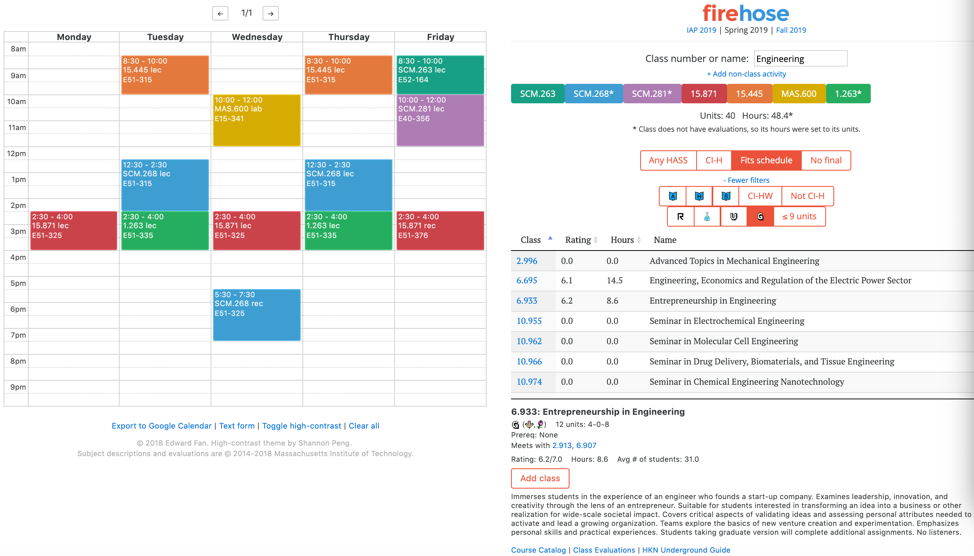“Studying at MIT is like drinking from a firehose”: by now you’ve probably heard this famous MIT analogy plenty of times. Indeed, studying in Cambridge will feel like gulping from an endless stream of knowledge.
One of the many things you will have to complete during your first weeks at MIT (regardless of SCM Residential or Blended program) is enrolling in the courses that will allow you to graduate, this will allow you to control a bit the throttle of that firehose. There are basically two approaches you can follow when choosing what to enroll in at MIT, there is no better or worse, so let’s call them the “efficient” and the “holistic” way.
It all comes down to where you set your priorities in this exciting new phase of your life. If you want to focus on job-search, networking, researching for your projects and attending as many conferences as possible during your time on campus, then you may want to choose the former approach. On the other hand, if you really want to maximize the purely academic aspect of your learning, then (provided you spend enough time and research) all academic doors will be open for you at MIT. This latter way is nevertheless not free of sweat, disappointment, head-scratching, patience, rejection, and the necessary bit of luck too.
The efficient way of choosing subjects relies on a very useful tool programmed by MIT students called – pertinently – “firehose.” This tool is a web-based scheduler, with which you can successively select courses, and will add up in a week overview (see image) where you can see how your weekly schedule potentially will look. This process is quite easy, in the case of SCM you have to successively add your mandatory courses first (which are non-negotiables in any scenario) to build the wireframe of your schedule. Then you add some SCM elective subjects up until the required number (see SCM curriculum here). Until this point you should have no schedule conflict, as Maria J. Saenz, Josue Velazquez and the team make sure that all SCM lectures fit. Now the most important setting in Firehose is to click on “Fits schedule”, this will make sure that any further subject added in your search does not conflict with your existing plan. Finally, you can search any keyword (“Artificial Intelligence”, “Entrepreneurship,”etc.) and choose a couple of other subjects up to a limit of 65 credits per semester.

As you will see, this method will lead you relatively quickly to a feasible solution for your class scheduling problem. But as you should know from Chris Caplice’s optimization lecture in edX by now, heuristics can get stuck on local maximums, while there may still be your global “academic” maximum out there.
In order to discover this global maximum, you will need to look further at the full solution space. This includes shifting around some subjects, discarding some previously selected ones, and even getting into a bidding war for Sloan credits. The full course catalog of MIT is available here. Just make sure in the MIT course catalog to filter for courses offered in your year and semester.
Now, when you thought you had all bases covered… let me multiply that choice by 4. MIT offers not only their own course catalog mentioned above, but also cross-registration with 3 other major universities in Boston and Cambridge — including a crimson-colored one, up the street from MIT — so you will meet in some of your classes and assignment groups students from other local universities cross-registered at MIT.
As for my unconventional choices beyond the pure SCM curriculum, to give you an example: I am taking a class in Human Augmentation at the Media Lab called Human 2.0. I can only say that the class is as fascinating as the MIT professor’s TED Talk online, which is how I found this course. I am also enrolled in a Sloan Class on Mergers, Acquisitions and Private Equity. It’s quite MBA / finance-oriented and I got in via the waitlist, but it is a deep personal and professional interest of mine, and the professor is amazing at fostering discussions in class. Finally, I’m taking a class at Harvard on “Urban Innovation: Using Technology to Drive Change”, brilliantly taught by former Indianapolis Mayor and NYC Deputy Mayor Professor Stephen Goldsmith.
In summary, no matter what your interests or preferences are, you will surely find courses at MIT that will challenge you and enhance your learning experience beyond Supply Chain, provided you put some effort into finding them and use the right tools.

